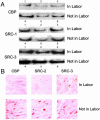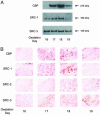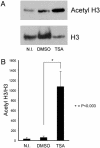A decline in the levels of progesterone receptor coactivators in the pregnant uterus at term may antagonize progesterone receptor function and contribute to the initiation of parturition
- PMID: 12886011
- PMCID: PMC170950
- DOI: 10.1073/pnas.1633616100
A decline in the levels of progesterone receptor coactivators in the pregnant uterus at term may antagonize progesterone receptor function and contribute to the initiation of parturition
Abstract
The molecular events that lead to the onset of labor in humans and in other mammalian species remain unclear. We propose that a decline in coactivators containing histone acetylase activity in myometrium may contribute to the onset of labor by impairing the function of the progesterone-progesterone receptor (PR) complex. As assessed by semiquantitative and real-time RT-PCR, immunohistochemistry, and immunoblotting, expression of the PR coactivators cAMP-response element-binding protein (CREB)-binding protein and steroid receptor coactivators 2 and 3 was decreased in fundal uterine tissue of women in labor. Using the mouse as an animal model, we also found decreased coactivator levels in uterine tissues at term. In both human and mouse, the levels of acetylated histone H3 were also decreased in uterine tissues at term. Administration of trichostatin A, a specific and potent histone deacetylase inhibitor, to pregnant mice late in gestation increased histone acetylation and delayed the initiation of parturition by 24-48 h, suggesting the functional importance of the decline in histone acetylation in the initiation of labor. These findings suggest that the decline in PR coactivator expression and in histone acetylation in the uterus near term may impair PR function by causing a functional progesterone withdrawal. The resulting decrease in expression of PR-responsive genes should increase sensitivity of the uterus to contractile stimuli.
Figures





References
-
- Virgo, B. B. & Bellward, G. D. (1974) Endocrinology 95, 1486-1490. - PubMed
-
- Challis, J. R. G., Matthews, S. G., Gibb, W. & Lye, S. J. (2000) Endocr. Rev. 21, 514-550. - PubMed
-
- Herrmann, W., Wyss, R., Riondel, A., Philibert, D., Teutsch, G., Sakiz, E. & Baulieu, E. E. (1982) C. R. Acad. Sci. Ser. III 294, 933-938. - PubMed
-
- McKenna, N. J., Lanz, R. B. & O'Malley, B. W. (1999) Endocr. Rev. 20, 321-344. - PubMed
Publication types
MeSH terms
Substances
Grants and funding
LinkOut - more resources
Full Text Sources
Other Literature Sources
Research Materials
Miscellaneous

